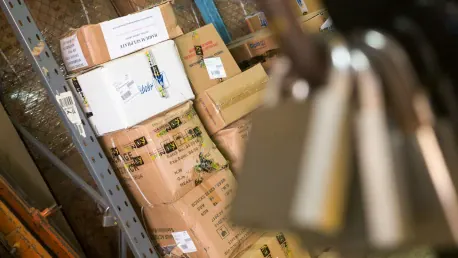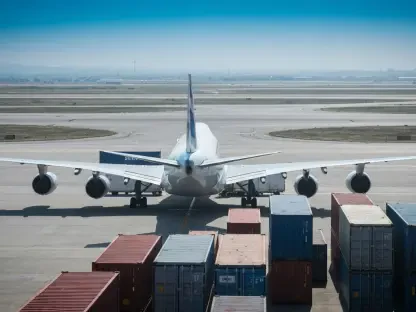The industrial landscape is evolving at an unprecedented pace, driven by the integration of artificial intelligence (AI) across various sectors, prominently within the supply chain. Workers in this sector are increasingly encountering heightened safety threats, brought on by both internal and external factors. Malicious actors are continuously exploiting vulnerabilities, leading to increased risks for personnel and goods alike. Amid these challenges, AI emerges as a vital tool, fortifying safety strategies and ensuring a secure working environment for all involved.
In recent years, substantial data has highlighted the growing risks faced by supply chain workers, particularly in terms of cargo theft and operational hazards. According to CargoNet, the trend of increasing cargo theft across the United States and Canada has continued, with material losses significantly impacting both the bottom line and worker safety. Such threats necessitate innovative solutions, and organizations are increasingly turning to AI to proactively detect and deter potential dangers. The Top Software and Tech Awards 2024 underscored this shift, showcasing advancements that enhance visibility, warehouse automation, and other critical areas through AI technologies.
Heightened Safety Threats and the Need for AI
Across the supply chain landscape, safety threats have become more pronounced, both in frequency and severity. The last quarter of 2024 saw a notable increase in cargo theft incidents, with over $39 million in goods reported stolen in the United States and Canada. These statistics not only underscore the financial impact on businesses but also the heightened risk faced by supply chain personnel. Workers are continually exposed to dangers inherent in loading and transporting goods over long distances, and the daily hazards are further magnified during peak ordering seasons.
To address these challenges, organizations are leveraging AI to implement advanced safety measures. AI’s capabilities allow for enhanced threat detection and proactive deterrence, reducing the likelihood of operational disruptions. By incorporating AI into their security strategies, companies are better equipped to protect their personnel and assets. The advancements recognized by the Top Software and Tech Awards 2024 highlight significant innovations in supply chain visibility, warehouse automation, robotics, and ERP solutions, all of which benefit from AI’s ability to interact effectively in real-world scenarios.
Driver Protection and Autonomous Capabilities
Driver protection is a critical area where AI demonstrates profound impact. Modern trucks are now equipped with sophisticated monitoring systems, including internal and external cameras and sensors. These devices can detect signs of driver distraction, drowsiness, or impairment by analyzing facial expressions and other indicators. Real-time alerts help prevent accidents, ensuring drivers remain focused and safe while on the road. Moreover, exterior cameras and sensors enhance road condition monitoring, enabling autonomous driving capabilities that further bolster safety and reduce cognitive load on drivers.
The integration of driverless technology with these monitoring features creates a robust framework for road safety. Autonomous driving systems can navigate complex routes and adjust to real-time traffic conditions, reducing the risk of collisions and enhancing overall efficiency. By optimizing driver performance and incorporating AI-driven automation, the supply chain sector can significantly mitigate the risks associated with long-haul transportation. This combination of technologies not only safeguards drivers but also optimizes logistical processes, leading to safer and more efficient supply chain operations.
Enhancing Incident Analysis and Response
When incidents occur within warehouses, on the road, or at rest stops, AI-driven video intelligence systems play a pivotal role in ensuring swift and effective responses. These systems can rapidly gather and analyze evidence from various recording devices, providing invaluable insights that aid in building cases for prosecution if needed. This capability is instrumental in addressing criminal activities, enabling organizations to take decisive actions based on concrete evidence. Video intelligence systems also facilitate real-time collaboration with local law enforcement, allowing for coordinated and prompt responses to incidents.
The ability to access video feeds in real-time ensures that law enforcement can monitor ongoing situations and intervene when necessary. This not only enhances the security within supply chain facilities but also contributes to community safety by deterring criminal behavior. AI’s role in incident analysis extends beyond just response; it also involves predictive capabilities that help identify potential threats before they materialize. By continuously learning from data and adapting to evolving conditions, AI systems provide a dynamic approach to incident management, ensuring that safety measures remain robust and effective.
Robotics and AI in Inventory Moving
AI-powered robotics have revolutionized inventory movement within supply chain operations. The use of intelligent forklifts and warehouse-navigating robots has streamlined processes involving potentially dangerous machinery, reducing the risk of human injury. These robots are equipped with advanced sensors that continuously scan their environment, ensuring safe and efficient movement of goods. By automating repetitive and hazardous tasks, AI-driven robotics remove humans from harm’s way, allowing for remote monitoring and intervention when necessary.
Fully automated solutions enable seamless operations within warehouses, from sorting and storing to retrieving and shipping products. These systems are designed to adapt to fluctuating volumes and changing layouts, maintaining high levels of efficiency and safety. Remote human oversight ensures that any anomalies or unexpected situations are promptly addressed, further bolstering operational security. The integration of AI in inventory moving not only enhances safety but also improves productivity, as robots can operate continuously without fatigue, maintaining optimal performance levels around the clock.
Advanced Inventory Tracking and Management
One of the key benefits of AI in supply chain operations is its ability to simplify inventory tracking and management. Overflow lots and warehouses now utilize AI-powered cameras to read truck identification labels, streamlining the tracking of incoming and outgoing shipments. Drones equipped with AI technologies navigate warehouse spaces to scan labels and containers, providing real-time updates on inventory status. This automation minimizes the reliance on manual processes, enhancing accuracy and reducing the incidence of errors.
AI systems also extend their capabilities to cargo ships, where container numbers are read and tracked, ensuring precise staging of shipments. In the event of delays or disruptions, these systems automatically update timelines and notify relevant stakeholders, ensuring timely communication and reducing operational downtime. By leveraging AI for inventory tracking, organizations can achieve better visibility into their supply chain processes, optimize resource allocation, and respond more effectively to changing demands. This increased transparency and control translate into improved overall efficiency and security within the supply chain ecosystem.
Video Surveillance and Compliance Monitoring
The industrial landscape is changing rapidly, largely due to the integration of artificial intelligence (AI) in various sectors, especially within supply chains. Workers in this field face increasing safety risks from both internal and external threats. Cybercriminals constantly exploit vulnerabilities, elevating risks for both personnel and goods. Amid these challenges, AI has proven to be a crucial tool, enhancing safety strategies and securing the working environment for everyone involved.
Recent data highlights the escalating risks for supply chain workers, particularly with issues like cargo theft and operational hazards. Reports from CargoNet indicate a rising trend in cargo theft in the United States and Canada, resulting in significant material losses that affect both financials and worker safety. These threats demand innovative solutions, and many organizations are now leveraging AI to proactively detect and mitigate potential dangers. The Top Software and Tech Awards 2024 showcased this shift by highlighting advancements that improve visibility, warehouse automation, and other critical areas using AI technologies.









